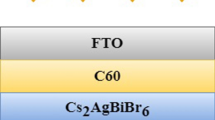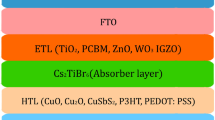Abstract
This work focuses on designing novel perovskite solar cells (PSCs) by working on the stability issues, the presence of lead in the PSC's structure, and its innately low efficiency. This work aims to overcome lead-based PSCs' shortcomings by optimizing various parameters of the double perovskite absorber layer and hole transport layer (HTL). The double perovskite \({\mathrm{Cs}}_{2}{\mathrm{AgBiBr}}_{6}\) material has been utilized as an absorber. The device performances are investigated with \(\mathrm{Spiro\,OMeTAD\, (S.O.)}\), \({\mathrm{Cu}}_{2}\mathrm{O}\), \({\mathrm{MASnBr}}_{3}\), \({\mathrm{P}}_{3}\mathrm{HT}\), \({\mathrm{Ni}}_{1-x}\mathrm{O}\), and Cu-doped \({\mathrm{Ni}}_{1-x}\mathrm{O}\) as HTLs and Mg-doped \(\mathrm{ZnO}\) \({(\mathrm{Zn}}_{x}{\mathrm{Mg}}_{1-x}\mathrm{O})\) as electron transport layer (ETL). Cu-doped \({\mathrm{Ni}}_{1-x}\mathrm{O}\) significantly boosts the performance of lead-free double perovskite-based solar cells. The device shows maximum power conversion efficiency (PCE) of 20.06%, Open-circuit voltage (\(V_{\mathrm{oc}})\) of 1.68 V, Short-circuit current density (\(J_{\mathrm{sc}}\)) of 14.81 \({\mathrm{mA}/\mathrm{cm}}^{2},\) and Fill-factor (FF) of 80.54%. Also, the effect of changing series resistance, shunt resistance, and temperature on the optimized device has been investigated. The optimized device shows more immunity and stability against temperature variations. These results can be utilized for designing high-performance, eco-friendly perovskite solar cells in the future. This study suggests that \({\mathrm{Cs}}_{2}{\mathrm{AgBiBr}}_{6}\) and some other double perovskites can be utilized as an important absorber toward the stable and efficient lead-free and inorganic PSCs for future eco-friendly technologies.









Similar content being viewed by others
Data availability
All data generated or analyzed during this study are included in this published article.
References
N. Lakhdar, A. Hima, Opt. Mater. (Amst). 99, 109517 (2020). https://doi.org/10.1016/j.optmat.2019.109517
C.J. Yu, J. Phys. Energy 1, 022001 (2019). https://doi.org/10.1088/2515-7655/aaf143
A. Raj, M. Kumar, H. Bherwani, A. Gupta, A. Anshul, J. Vac. Sci. Technol. B 39, 012401 (2021). https://doi.org/10.1116/6.0000718
I. Mesquita, L. Andrade, A. Mendes, Renew. Sustain. Energy Rev. 82, 2471 (2018). https://doi.org/10.1016/j.rser.2017.09.011
Y. Chen, L. Zhang, Y. Zhang, H. Gao, H. Yan, RSC Adv. 8, 10489 (2018). https://doi.org/10.1039/c8ra00384j
N.K. Noel, S.D. Stranks, A. Abate, C. Wehrenfennig, S. Guarnera, A.A. Haghighirad, A. Sadhanala, G.E. Eperon, S.K. Pathak, M.B. Johnston, A. Petrozza, L.M. Herz, H.J. Snaith, Energy Environ. Sci. 7, 3061–3068 (2014). https://doi.org/10.1039/c4ee01076k
C. Wu, Q. Zhang, Y. Liu, W. Luo, X. Guo, Z. Huang, H. Ting, W. Sun, X. Zhong, S. Wei, S. Wang, Z. Chen, L. Xiao, Adv. Sci. 5, 759 (2018). https://doi.org/10.1002/advs.201700759
Q. Mahmood, M. Hassan, N. Yousaf, A.A. AlObaid, T.I. Al-Muhimeed, M. Morsi, H. Albalawi, O.A. Alamri, Mater. Sci. Semicond. Process. 137, 106180 (2022). https://doi.org/10.1016/j.mssp.2021.106180
T.I. Alanazi, Crystals 13, 267 (2023). https://doi.org/10.3390/cryst13020267
A. Mohandes, M. Moradi, H. Nadgaran, Opt. Quantum Electron. 53, 1 (2021). https://doi.org/10.1007/s11082-021-02959-z
S. Madani, T. Tesfamichael, H. Wang, N. Motta, Ceram. Int. 48, 15207 (2022). https://doi.org/10.1016/j.ceramint.2022.02.051
G. Pindolia, S.M. Shinde, P.K. Jha, Sol. Energy 236, 802 (2022). https://doi.org/10.1016/j.solener.2022.03.053
N. Gamal, S.H. Sedky, A. Shaker, M. Fedawy, Optik (Stuttg). 242, 167306 (2021). https://doi.org/10.1016/j.ijleo.2021.167306
S. Ahmed, F. Jannat, M.A.K. Khan, M.A. Alim, Optik (Stuttg). 225, 165765 (2021). https://doi.org/10.1016/j.ijleo.2020.165765
L.J. Chen, RSC Adv. 8, 18396 (2018). https://doi.org/10.1039/c8ra01150h
P.K. Patel, Sci. Rep. 11, 1 (2021). https://doi.org/10.1038/s41598-021-82817-w
S.C. Yadav, V. Manjunath, A. Srivastava, R.S. Devan, P.M. Shirage, Opt. Mater. (Amst). 132, 112676 (2022). https://doi.org/10.1016/j.optmat.2022.112676
A. Tara, V. Bharti, S. Sharma, R. Gupta, Opt. Mater. (Amst). 119, 111362 (2021). https://doi.org/10.1016/j.optmat.2021.111362
S. Bansal and P. Aryal, 2017 IEEE 44th Photovoltaic Specialist Conference PVSC vol. 8, p. 3220 (2017). https://doi.org/10.1109/PVSC.2017.8366107
D. Zhao, C. Liang, B. Wang, T. Liu, Q. Wei, K. Wang, H. Gu, S. Wang, S. Mei, G. Xing, Energy Environ. Mater. 5, 1317 (2022). https://doi.org/10.1002/eem2.12249
M.T. Sirtl, R. Hooijer, M. Armer, F.G. Ebadi, M. Mohammadi, C. Maheu, A. Weis, B.T. van Gorkom, S. Häringer, R.A.J. Janssen, T. Mayer, V. Dyakonov, W. Tress, T. Bein, Adv. Energy Mater. (2022). https://doi.org/10.1002/aenm.202103215
B.S. Sengar, V. Garg, A. Kumar, P. Dwivedi, IEEE Trans. Electron Devices 68, 2360 (2021). https://doi.org/10.1109/TED.2021.3066454
D. Zhou, T. Zhou, Y. Tian, X. Zhu, Y. Tu, Nanomaterials 2018, 8148072 (2018). https://doi.org/10.1155/2018/8148072
M. Feng, M. Wang, H. Zhou, W. Li, S. Wang, Z. Zang, S. Chen, ACS Appl. Mater. Interfaces 12, 50684 (2020). https://doi.org/10.1021/acsami.0c15923
G. Longo, S. Mahesh, L.R.V. Buizza, A.D. Wright, A.J. Ramadan, M. Abdi-Jalebi, P.K. Nayak, L.M. Herz, H.J. Snaith, ACS Energy Lett. 5, 2200 (2020). https://doi.org/10.1021/acsenergylett.0c01020
A. Basak, U.P. Singh, Sol. Energy Mater. Sol. Cells 230, 111184 (2021). https://doi.org/10.1016/j.solmat.2021.111184
N. Kumar, D.S. Ghosh, A. Khare, Opt. Mater. (Amst). 129, 112517 (2022). https://doi.org/10.1016/j.optmat.2022.112517
S. Ghosh, S. Porwal, T. Singh, Optik (Stuttg). 256, 168749 (2022). https://doi.org/10.1016/j.ijleo.2022.168749
M.M. Salah, A. Zekry, M. Abouelatta, A. Shaker, M. Mousa, Crystals 12, 2070878 (2022). https://doi.org/10.3390/cryst12070878
Acknowledgements
The authors acknowledge the Department of Science and Technology (DST), Govt. of India for the financial assistance provided under DST SERB Project (File No. SRG/2021/002110) to carry out the present work. Dr. Amitesh Kumar would like to thank DST SERB for providing a Start-up Research Grant for this project to conduct research at NIT Patna. Mr. Pritam Kumar would like to thank the Department of Electrical Engineering, NIT Patna for providing research facilities. The authors are thankful to Prof. Marc Burgelman, University of Gent, Belgium for providing the SCAPS-1D software for our studies.
Funding
The authors acknowledge the Department of Science and Technology (DST), Govt. of India for the financial assistance provided under DST SERB Project (File No. SRG/2021/002110) to carry out the present work.
Author information
Authors and Affiliations
Contributions
PK contributed toward conceptualization, methodology, software, data curation, visualization, investigation, writing, and original draft preparation. AK contributed toward conceptualization, methodology, formal analysis, supervision, reviewing, and editing.
Corresponding author
Ethics declarations
Conflict of interest
The authors declare that they have no conflict of interest.
Ethical approval
Not applicable.
Additional information
Publisher's Note
Springer Nature remains neutral with regard to jurisdictional claims in published maps and institutional affiliations.
Rights and permissions
Springer Nature or its licensor (e.g. a society or other partner) holds exclusive rights to this article under a publishing agreement with the author(s) or other rightsholder(s); author self-archiving of the accepted manuscript version of this article is solely governed by the terms of such publishing agreement and applicable law.
About this article
Cite this article
Kumar, P., Kumar, A. High-performance optimization and analysis of Cs2AgBiBr6-based lead-free double perovskite solar cells. J Mater Sci: Mater Electron 34, 1810 (2023). https://doi.org/10.1007/s10854-023-11225-9
Received:
Accepted:
Published:
DOI: https://doi.org/10.1007/s10854-023-11225-9




